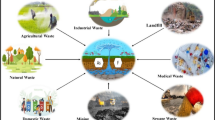Abstract
Recovery of valuable metals from acidic mine drainage (AMD) during bioremediation using straw bioremediation system was investigated, with observation of efficient metal recovery. The recovery loading rates of Cu and Zn were 46.19 ± 6.13 and 43.86 ± 6.76 mg m−3 h−1, respectively. More than 97.0% of Cu and more than 87.0% of Zn were recovered from AMD during bioremediation. The recovery loading rate of Cu increased by 4.54 mg m−3 h−1 for each 1 mg L−1 increase in influent concentration while that of Zn increased by 4.08 mg m−3 h−1. Heavy metal toxic effect on the metal recovery in the straw bioremediation system could be neglected in most cases. Low pH could severely decrease recovery rate of Zn, while it had no influence on that of Cu. The recovery loading rate of Zn decreased by almost 70% when the influent pH decreased from 7.0 to 3.0. Cu could be recovered efficiently even at a short hydraulic residence time (HRT) of 18 h, while Zn could only be efficiently recovered at a relatively long HRT of 80 h, indicating that selective metal recovery might be achieved with relatively short HRT and bioreactor process optimization. These findings suggested the feasibility of using sulfate-reducing straw bioremediation system to recover valuable metals during bioremediation of AMD.






Similar content being viewed by others
References
Benner, S. G., Blowes, D. W., Gould, W. D., Herbert, R. B., & Ptacek, C. J. (1999). Geochemistry of a permeable reactive barrier for metals and acid mine drainage. Environmental Science and Technology, 33, 2793–2799.
Bhattacharyya, D., Jumawan, A. B., Sun, G., Sund-Hagelberg, C., & Schwitzgebel, K. (1981). AIChE symposium series. In G. F. Bennett (Ed.), Water-1980 (pp. 31–38). New York: American Institute of Chemical Engineering.
Chang, I. S., Shin, P. K., & Kim, B. H. (2000). Biological treatment of acid mine drainage under sulphate-reducing conditions with solid waste materials as substrate. Water Research, 34, 1269–1277.
Druschel, G. K., Baker, B. J., Gihring, T. M., & Banfield, J. F. (2004). Acid mine drainage biogeochemistry at Iron Mountain, California. Geochemical Transactions, 5, 13–32.
Emsley, J. (2001). “Zinc”, nature’s building blocks: an A–Z guide to the elements. Oxford: Oxford University Press.
Gusek, J. J., Wildeman, T. R., & Conroy, K. W. (2006). Conceptual methods for recovering metal resources from passive treatment systems. In M. O. St. Louis & R. I. Barnhisel (Eds.), The 7th International Conference on Acid Rock Drainage (ICARD). Lexington: American Society of Mining and Reclamation (ASMR).
Harper, S. H. T., & Lynch, J. M. (1981). The chemical components and decomposition of wheat straw leaves, internodes and nodes. Journal of the Science of Food and Agriculture, 32, 1057–1062.
Huisman, J. L., Schouten, G., & Schultz, C. (2006). Biologically produced sulphide for purification of process streams, effluent treatment and recovery of metals in the metal and mining industry. Hydrometallurgy, 83, 106–113.
Hulshof, A. H. M., Blowes, D. W., Ptacek, C. J., & Gould, W. D. (2003). Microbial and nutrient investigations into the use of in situ layers for treatment of tailings effluent. Environmental Science and Technology, 37, 5027–5033.
Hulshof, A. H. M., Blowes, D. W., & Gould, W. D. (2006). Evaluation of in situ layers for treatment of acid mine drainage: a field comparison. Water Research, 40, 1816–1826.
Jin, S., Fallgren, P. H., & Morris, J. M. (2008). Biological source treatment of acid mine drainage using microbial and substrate amendments: microcosm studies. Mine Water and the Environment, 27, 20–30.
Jurjovec, J., Ptacek, C. J., & Blowes, D. W. (2002). Acid neutralization mechanisms and metal release in mine tailings: A laboratory column experiment. Geochimica et Cosmochimica Acta, 66, 1511–1523.
Lu J., Chen T., Wu J., Wilson P.C., Hao X., & Qian J. (2011). Acid tolerance of an acid mine drainage bioremediation system based on biological sulfate reduction. Bioresource Technology, 102, 10401–10406.
Luptakova, A., & Kusnierova, M. (2005). Bioremediation of acid mine drainage contaminated by SRB. Hydrometallurgy, 77, 97–102.
Noelte, J. (2002). ICP Emissionsspektometrie für Praktiker. Weinheim: Wiley-VCH.
Rittmann, B. E., & McCarty, P. L. (2001). Environmental biotechnology: Principles and applications (2nd ed.). Boston: McGraw-Hill.
Skousen, J., Rose, A., Geidel, G., Foreman, J., Evans, R., & Hellier, W. (1998). Handbook of technologies for avoidance and remediation of acid mine drainage. Morgantown: The National Mine Land Reclamation Center, West Virginia Unviersity.
Wikipedia, Wikimedia Foundation, Inc. (2010).Web interface: http://en.wikipedia.org/wiki/Copper_monosulfide.
Wu, J., Lu, J., Chen, T. H., He, Z., Su, Y., Jin, X., et al. (2010). In situ biotreatment of acidic mine drainage using straw as sole substrate. Environmental Earth Science, 60, 421–429.
Zagury, G. J., Kulnieks, V. I., & Neculita, C. M. (2006). Characterization and reactivity assessment of organic substrates for sulphate-reducing bacteria in acid mine drainage treatment. Chemosphere, 64, 944–954.
Acknowledgments
This work is financially supported by the National Foundation of Science of China (grant no. 40801217), the State Key Program of National Natural Science of China (Grant No. 41130206), National Key Basic Research Program (grant no. 2007CB815603), National Key Basic Pre-Research Program (grant no. 2011CB411904), and the Science Foundation of Hefei University of Technology (grant no. 2009HGCX0233). The authors would like to thank the reviewers for their valuable suggestions and comments on the manuscript.
Author information
Authors and Affiliations
Corresponding author
Rights and permissions
About this article
Cite this article
Lu, J., Wu, J., Chen, T. et al. Valuable Metal Recovery During the Bioremediation of Acidic Mine Drainage Using Sulfate Reducing Straw Bioremediation System. Water Air Soil Pollut 223, 3049–3055 (2012). https://doi.org/10.1007/s11270-012-1087-7
Received:
Accepted:
Published:
Issue Date:
DOI: https://doi.org/10.1007/s11270-012-1087-7




